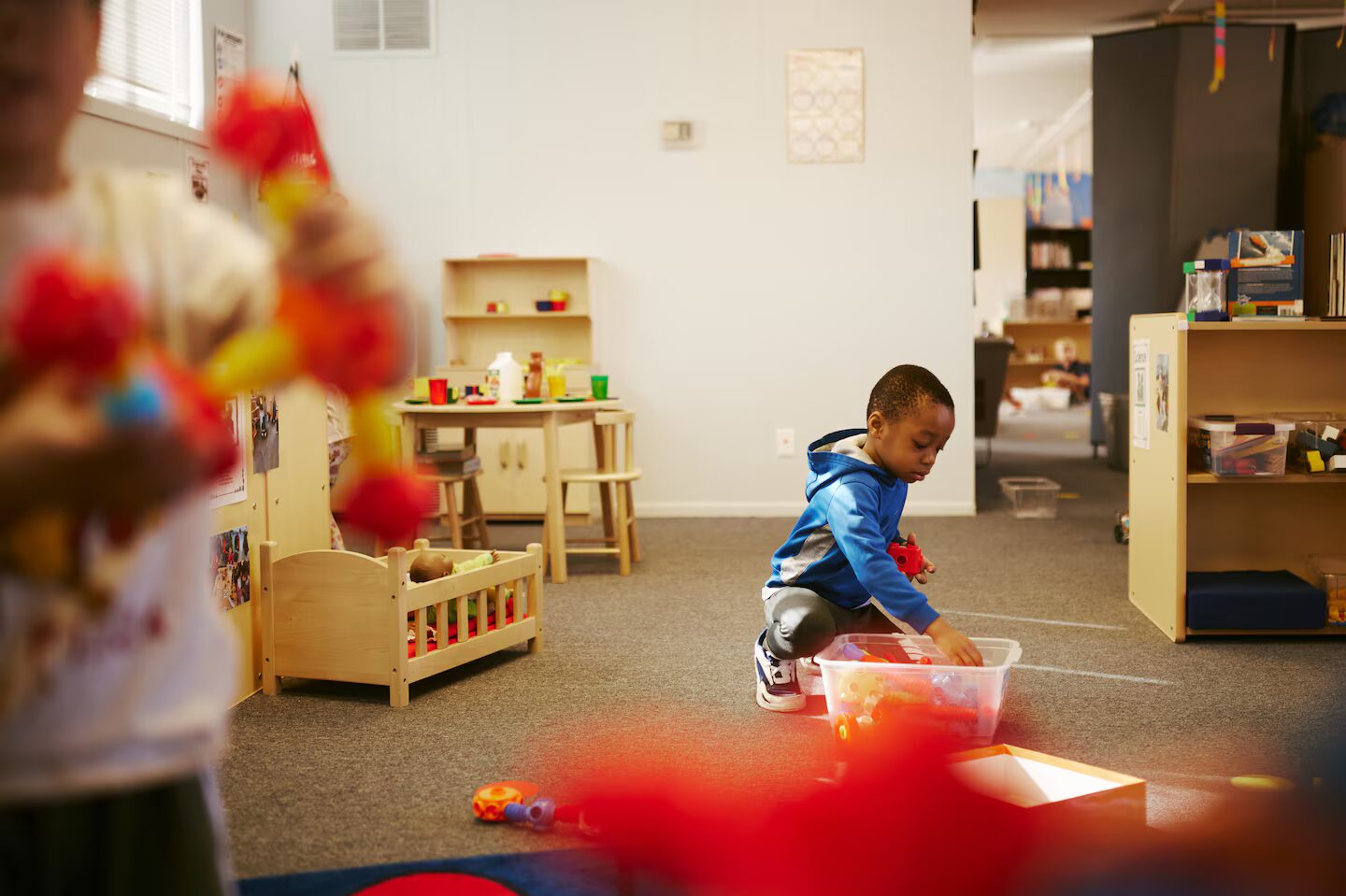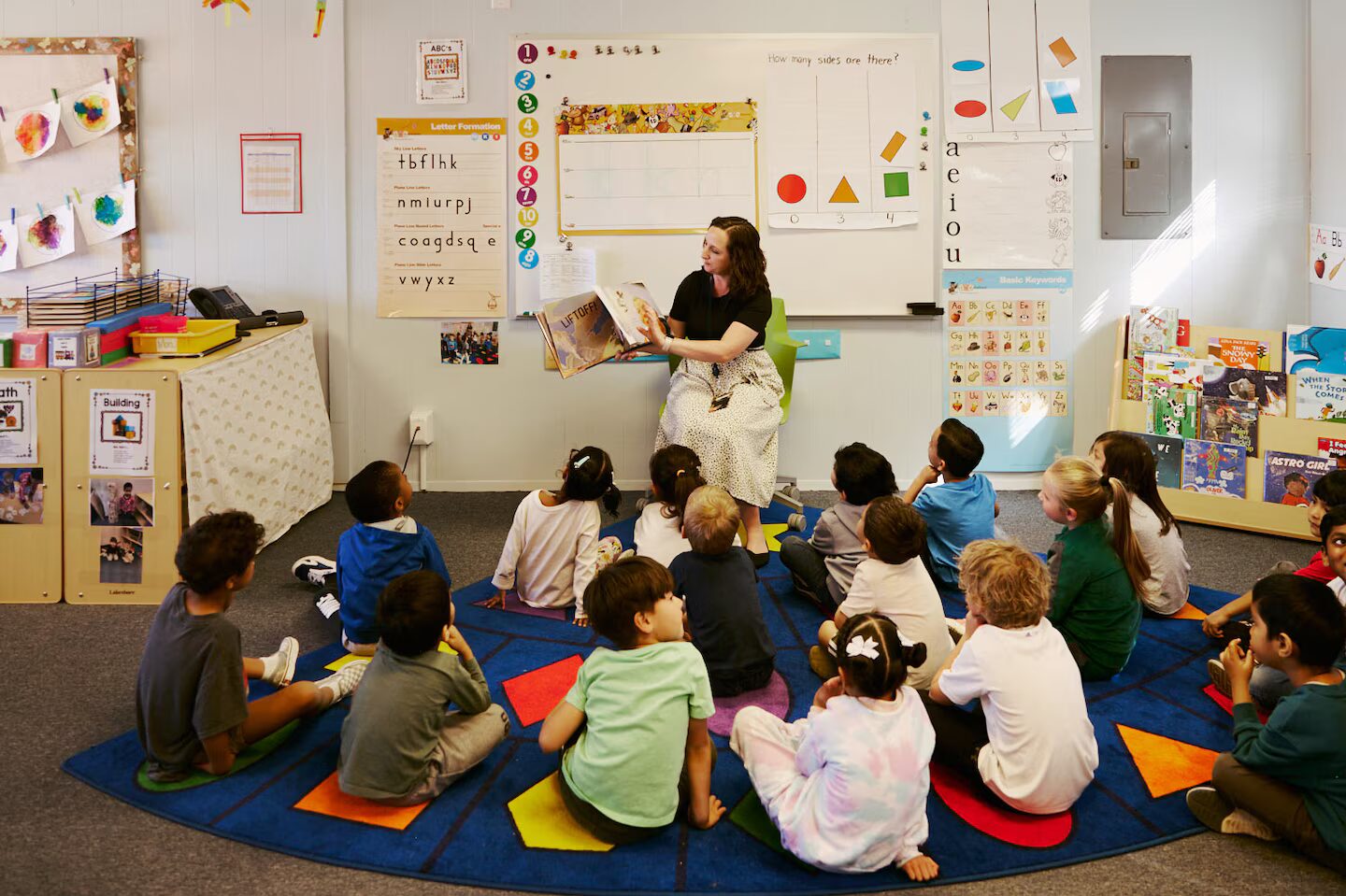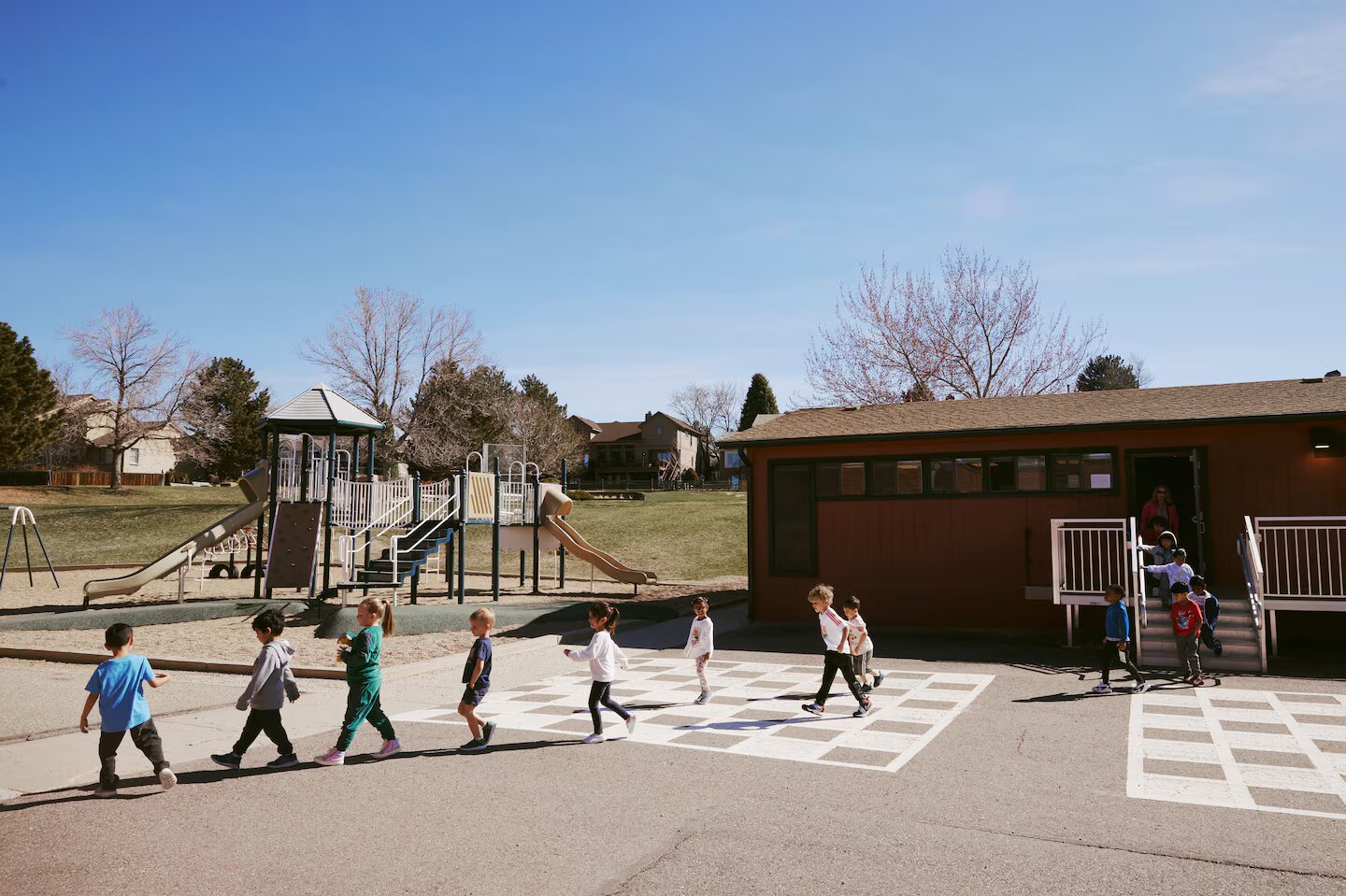This story was originally published by Chalkbeat. Sign up for their newsletters.
Two best friends sat at a small wooden table planning a party on the phone. Would they have cake or cupcakes? Both, they decided.
But the dessert, like the party, was pretend. The girls were 4 years old, the table was knee-high, and the phones were red plastic. The girls sometimes held them up to their ears and other times gleefully spun them like tops on picture books in front of them.
The girls are part of the inaugural class of preschoolers at High Plains Elementary School in the Cherry Creek school district southeast of Denver. Their classroom, tucked inside a portable building, is one of dozens added over the past year as part of the district’s dramatic preschool expansion.
Last school year, the 52,000-student district offered preschool classes at about half of its 44 elementary school campuses. Today, all but one offer preschool.
The district’s growing early childhood footprint has been pushed along by Colorado’s new universal preschool program and the availability of vacant space as elementary enrollment declines. It also fits with broader trends as public schools nationwide increasingly jump into the preschool game — particularly for 4-year-olds.
Jimena Peck/For Chalkbeat
Two preschoolers at High Plains Elementary School spin their plastic phones while they plan a pretend party.
If the trend persists, “We’ll see what we kind of saw happen with kindergarten over the past 40 years, where kindergarten [became] institutionalized as a fixed part of elementary schools,” said Michael Little, assistant professor of educational evaluation and policy analysis at North Carolina State University.
Generally, experts say adding preschool in public schools is a good thing, expanding options for families, aligning preschool learning to what’s taught in higher grades, and easing the transition for incoming kindergartners. At the same time, they note that administrators and educators must ensure their preschool classrooms are developmentally appropriate, with lots of time for play.
“I don’t want to see preschool become this mini boot camp for third grade reading scores,” said Cathrine Aasen Floyd, director of ideal learning initiatives at the Trust For Learning. “Play isn’t a distraction from learning. Play is the vehicle for learning.”
Cherry Creek is one of four districts among the state’s 15 largest that offer preschool at more than 90% of elementary and K-8 buildings. The others are Aurora, Colorado Springs 11, and the Brighton-based District 27J. Two-thirds of the 15 largest districts also have at least one standalone early childhood center with preschool. Greeley-Evans, a growing district in northern Colorado, offers preschool at the smallest share of schools — 35%.
Cherry Creek spent $6 million to create or retrofit classrooms at 23 campuses for preschool this year. It will add preschool at the last elementary school by August. The district currently enrolls about 1,500 4-year-olds in preschool, and officials say most schools have room for more.
District leaders said expanding preschool districtwide was “the right thing to do” because district families strongly prefer schools near their homes.
“They want to go to their neighborhood school where they’re going to go to kindergarten, where they see their siblings go, where the other kids in the neighborhood are going,” said Scott Smith, the district’s chief financial and operating officer.
While the state’s universal preschool program influenced Cherry Creek to expand its preschool offerings, the district has not been entirely happy with the program. Cherry Creek is among six school districts suing the state, alleging that the officials have broken funding promises and that the program’s administration has harmed special education students.

Jimena Peck/For Chalkbeat
Preschool students at High Plains Elementary School on Thurs., April 4, 2024 in Greenwood Village, Colorado.
Families want easy access to preschool
Dana Polun and her family live around the corner from High Plains Elementary. She can hear children on the playground from her backyard.
Her youngest son, 5-year-old Dexter, attends morning preschool classes at High Plains four days a week. That part of the day is free because of Colorado’s new universal preschool program, which covers the cost of part-day preschool for 4-year-olds statewide.
The Poluns, who also have a son in third grade at High Plains, pay for Dexter to stay at school for lunch and afternoon “enrichment.” He could have continued at the child care center he attended last year, but convenience was a key factor in the family’s decision.
“Why do two picks-up and two drop-offs, one of them walking, one of them driving?” she said.
She is pleased with Dexter’s experience this year. He’s recognizing letters and numbers, and can write his name. He’s met children from the neighborhood and sometimes her boys hug when they come across each other in the school hallway.
The only downside this year is that Dexter has no school on Fridays. That’s when Polun, who works for an interior designer, tries to arrange playdates with her son’s preschool friends. If that doesn’t pan out, her work on the computer is often accompanied by a constant refrain: “Mom, mom, mom, mom.”

Jimena Peck/For Chalkbeat
Rachel Rosen, who co-teaches preschool at High Plains Elementary School, reads a book about a mouse who travels into outer space.
Colorado tracks national trends
In the mid-1980s, about 10% of the nation’s elementary schools offered preschool, according to a 2021 Urban Institute report. By 2019-20, that number was close to 60%.
Some early childhood advocates worry the push for preschool in public schools could hurt private child care programs by siphoning off 4-year-olds, leaving them with younger children who are more expensive to serve.
Dawn Alexander, who heads the Early Childhood Education Association, a trade group for private child care providers, said putting preschools in public schools is one of several public policies “undermining the economics of the child care industry.”
While there’s certainly some competition for preschoolers, there are also many thousands of children who don’t attend preschool at all. Only about 40% of 3-year-olds and 60% of 4-year-olds attended in 2022, according to U.S. Census data.
The proliferation of government funded preschool programs has contributed to the growth of preschool in public schools. That’s true in Denver, said Priscilla Hopkins, the district’s director of early education.
Preschool offerings in the district ramped up after voters passed a sales tax hike in 2006 to fund the Denver Preschool Program, a citywide preschool tuition assistance program, she said. At the time, 53 district schools offered preschool.
[Related: Universal prekindergarten is coming to California — bumpy rollout and all]
Today, 77 of 90 district-run elementary and K-8 schools offer preschool. The district also has four stand-alone preschool centers and seven charter schools with preschool.
“One of the things that is really striking to me is how kind of first-on-the-scene Denver was seeing this is something our families want,” Hopkins said.
Falling birthrates have also led public schools to embrace preschool.
“A school begins to be financially impractical” as enrollment declines, said W. Steven Barnett, senior co-director of the National Institute for Early Education Research at Rutgers University. “Nobody in that neighborhood wants you to close that school … Preschool is certainly another way of making the finances work.”
That’s part of the calculus in the Cherry Creek district, which has lost about 3,400 students in the last five years, dropping from nearly 56,000 in 2018-19.
If there’s a benefit to such losses, said Smith, the district’s chief financial and operating officer, it’s that “we can look at space differently and not have a deficit mindset of just saying, ‘Oh, we have to close schools because we’ve got declining enrollment in certain areas.”

Jimena Peck/For Chalkbeat
There are 18 children in the preschool class at High Plains Elementary School in the Cherry Creek district southeast of Denver.
In the Adams 12 district northwest of Denver, only 17 of 35 elementary and K-8 schools currently offer preschool, but leaders there say they plan to bring preschool to every elementary eventually.
“I don’t think it’s going to happen overnight, but I do know that there are four to six schools on the docket as we think about the next year or so,” said Kim Walsh, the district’s interim preschool director.
All have lost enrollment in recent years, she said. So has Adams 12 as a whole, shrinking by 4,300 students — or nearly 11% — over five years, dropping from 39,000 in 2018-19.
Even growing districts try to provide preschool
Preschool expansion can be a trickier scenario in growing school districts.
The 27J district, just north of Denver, has been one of the fastest-growing districts in the state in recent years. But officials gradually added preschool classrooms at older schools and incorporated them into the floor plan at new schools. By 2018, every elementary and K-8 school had preschool, said Bethany Ager, the district’s early childhood education coordinator.
[Related: Q&A: There was no guide to looking for child care. Now there is.]
The streak ended in 2023, when the district opened Discovery Magnet School, a new science-focused school. District officials tried to find a way to shoehorn one preschool classroom into the floor plan, but couldn’t make it work. There simply wasn’t enough space.
While the district has preschool classrooms in nearly every school, plus a stand-alone early childhood center, Ager said demand for preschool seats is outpacing supply, especially in the rapidly developing southern part of the district.
District officials will add five new classrooms across three elementary schools by August. Even so, Ager said, “We’ll make it by the skin of our teeth next year.”

Jimena Peck/For Chalkbeat
Preschoolers at High Plains Elementary attend class in a spacious portable building just behind the school four mornings a week.
Public school programs can benefit preschoolers
Experts say top-notch preschools exist in both public schools and private centers, and that each setting can meet the needs of families depending on work schedules, location, and the age of other kids in the family.
But public schools have the potential to provide unique benefits in terms of a child’s educational continuity, they say.
Potential is the operative word.
Little, the North Carolina State University professor, said research is generally inconclusive about the benefits of attending preschool in a public school versus a private setting, likely because public schools don’t take full advantage of the opportunities that come with on-site preschool.
For example, they may not include preschool teachers in training and planning sessions, share preschool data with teachers in higher grades, and ensure that preschoolers have chances to visit kindergarten classrooms as part of “moving-up” days.
“We hear often that pre-K programs might just sit down at the end of the hall and there’s no integration and alignment happening,” Little said. “That might be part of why we don’t necessarily see really, really clear advantages in terms of student outcomes.”
Barnett, of the National Institute for Early Education Research, said his research indicates that preschools in public schools offer more developmentally appropriate instruction than private preschools do.
A working paper he co-authored — but has not yet published — found that preschool teachers in both public schools and Head Start programs reported more play-based and child-centered activities and less frequent use of flashcards and math worksheets than did teachers in private preschool programs.
The popular conception that preschool in public schools is more “skill and drill,” he said, “is completely opposite of reality.”
***
Ann Schimke is a senior reporter at Chalkbeat, covering early childhood issues and early literacy. Her work has appeared in The Washington Post, The Atlantic, and the Denver Post.
Chalkbeat is a nonprofit news organization covering public education.
Sign up for Chalkbeat Colorado’s free daily newsletter to get the latest reporting from us, plus curated news from other Colorado outlets.

